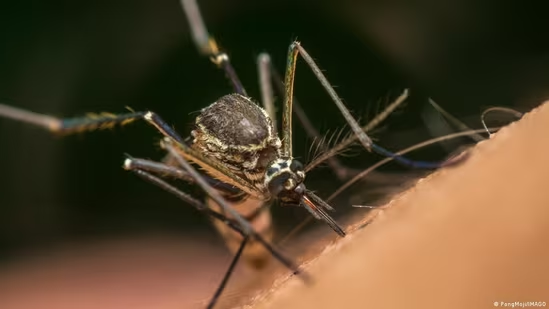Malaria: Why do case numbers not decrease?
Globally, the number of malaria cases has plateaued since 2015 and, in certain regions, has even begun to rise. That comes after declining numbers for 20 years. What is happening?

Charities, governments, and private benefactors all committed billions of dollars to the fight against malaria in the 1990s. By 2010, they aimed to cut the number of malaria fatalities worldwide in half.
Malaria was one of the world’s worst health hazards at the time. Every year, the sickness claimed the lives of at least a million individuals, the great majority of whom being young children.
In 1998, the “Roll Back Malaria” campaign was formally launched. Partner groups began distributing mosquito bed nets and indoor pesticide sprays in afflicted areas with support worth billions of dollars from international institutions such as the World Bank and the World Health Organization. In order to treat patients in regions where mosquitoes had developed resistance to chloroquine, the primary antimalarial medication available at the time, they also devised other medications.
In fewer than 20 years, these initiatives succeeded in cutting the number of malaria fatalities in half.
Stagnation followed by a dramatic rise in the number of malaria cases
However, things began to stagnate in 2015. The estimated number of cases remained constant for a few years before beginning to grow.
Malaria fatalities worldwide reached a six-year peak in 2020. Additionally, the predicted number of malaria cases worldwide increased dramatically, from around 230 million in 2014 to over 248 million in 2022.
Nicholas White, a malaria expert and professor of tropical medicine at the University of Oxford, published a plea to the WHO in the Lancet medical journal in response to these depressing projections. He added that their own estimates of the number of malaria cases in 2000 and 2022 were exactly the same.
What was wrong, he said, if this was really the case? Was it really the fact that after years of research into preventive cures, billions of dollars in worldwide investment, and billions of treatments being provided, the number of cases remained constant?
In response to White’s inquiry, the WHO said that he had misinterpreted the data since he had not taken into consideration the rate of population increase worldwide.
“If the global malaria incidence and mortality rate in 2000 were applied to populations at risk annually to 2020, the investments made over the past 20 years would have contributed to an estimated 11 million lives saved and 1.7 billion cases averted since 2000,” the World Health Organization said.
However, as stated in the headline of their statement, the organization admitted that “The message on malaria is clear: progress has stalled.”
‘Arms race’ to combat malaria
The group claims that there are “complex” reasons behind this halt. It responded to White by stating that the region most at risk from malaria, sub-Saharan Africa, is experiencing a shortage of money for interventions and poor access to high-quality medical treatment. “Biological threats” have contaminated the available instruments, they said.
According to experts DW interviewed, the capacity of malaria-carrying mosquitoes to swiftly adapt to and avoid interventions is probably the main cause of the stalemate, at least in part.
According to Jackie Cook, a co-director of the Malaria Center at the London School of Hygiene and Tropical Medicine, many of the mosquitoes that carry the malaria parasite have developed resistance to the primary insecticide used to control the disease, and in certain areas, the parasite itself has developed resistance to the medications used to treat it.
In addition, over the last ten years, a new mosquito species known as Anopheles stephensi has evolved in East Africa. The stephensi malaria vector may spread across cities, unlike other malaria vectors, which puts individuals residing in confined urban settings at risk.
Umberto D’Alessandro, a malaria researcher and the head of the Medical Research Council Unit in the Gambia at the London School of Hygiene and Tropical Medicine, told DW that “you have to see malaria control as an arms race.”
According to him, mosquitoes and parasites adapt as fast as pesticide sprays, drugs, or swift testing are created. “It’s a continuous search for intervention.”
Additionally, funding for malaria research is declining, according to experts. According to the WHO, funding for malaria research and development fell to its lowest point in the previous 15 years in 2022, the most recent year for which data is available.
“In 2007, Bill and Melinda Gates announced they wanted it [malaria] eliminated… in their lifetime, which I think is extremely unlikely, but there was a big push to try and do that,” Cook explained. “Obviously there have been successes, but I think people are starting to realize it’s not going to be a very straightforward thing.”
urging a thorough investigation of the malaria problem
Oxford malaria expert White disputes the notion that the capacity of vectors to swiftly evade treatments provides a definitive explanation for the stalemate.
Regarding the WHO’s estimates of malaria cases, White told DW that “at least that I’m aware of — and I should be aware of it — there hasn’t been an in-depth analysis which really explains why they estimate malaria has got worse since 2015.”
He expressed his suspicion that a significant portion of the stagnation is caused by variables such as “war, privation and economic downturn” and “things that nobody wants to talk about, such as corruption and inefficiencies,” which fall beyond the purview of health systems.
DW requested a statement from the WHO. They sent the query to Abdisalan Noor, the author of White’s answer, who is no longer employed at the WHO. When asked for a remark, he remained silent.
The World Health Organization (WHO) blamed the standstill in the 11 most afflicted countries in its 2023 World malaria report on a number of factors, including budget shortages, continuing wars, the impact of COVID-19 on service delivery, and problems with treatments like pesticide resistance.
The use of vaccines is beginning to aid in the battle against the illness. The RTS,S and the R21/Matrix M are the two malaria vaccines that the WHO has so far authorized. While the R21 deployment is scheduled to begin in May 2024, distribution of the RTS,S has already started. Although they are upbeat, experts caution that vaccinations are not a panacea.






